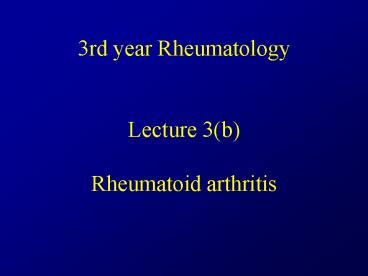3rd year Rheumatology Lecture 3b Rheumatoid arthritis - PowerPoint PPT Presentation
1 / 17
Title:
3rd year Rheumatology Lecture 3b Rheumatoid arthritis
Description:
variable course with exacerbations and remissions of activity ... Immunopathology. Aggregates of T-cells, macrophages and plasma cells in SM. Activated phenotype ... – PowerPoint PPT presentation
Number of Views:119
Avg rating:3.0/5.0
Title: 3rd year Rheumatology Lecture 3b Rheumatoid arthritis
1
3rd year RheumatologyLecture 3(b)Rheumatoid
arthritis
2
Introduction
- RA is a common chronic inflammatory joint
condition - multifactorial aetiology
- variable course with exacerbations and remissions
of activity - inflammation leads to joint damage (erosions)
- can result in severe disability
3
History
- Rheumatoid first used in 1859 by Garrod
- Little evidence for RA prior to 16th Century
- Possibly earlier in New World
- In contrast to OA and Gout
4
Epidemiology
- Incidence
- 1.4/10000 male, 3.6/10000 females
- Prevalence 0.5-2
- malefemale 13
- Worldwide distribution
- higher in native Americans
- absent in some parts of Africa
- Onset any age but maximum
- 40 - 70 years in women
- 60 - 70 years in men
5
Genetic factors
- Small increased risk in siblings
- Monozygotic twins
- 15 concordance
- Dizygotic twins
- 4 concordance
- HLA DR4
6
Clinical features
- Symmetrical deforming polyarthritis
- affects synovial lining of joints, bursae and
tendons - more then just joint disease
- Presentation
- Variable
- Gradual or acute/subacute
- Palindromic
- Monoarticular
- Symmetrical, diffuse small joint involvement
7
Progression of joint involvement
- Spread occurs within months to years to other
joints - Almost any joint may be involved
- Spontaneous remission can occur (after acute
onset) - Poor prognosis factors exist
- Symptoms
- Of inflammation
- stiffness, pain, swelling, warmth, redness
8
Pattern of joint involvement
- symmetrical
- small joints of hands - DIP spared
- characteristic features
- Boutonniere
- Swan neck
- Z thumb
- Volar subluxation
- Ulnar deviation
9
Functional impairment
- related to underlying disease activity and
- joint damage due to previous activity
10
Extra articular disease
- nodules
- eye
- lung
- kidney
- vasculitis
- nerves
- Feltys
11
Investigations
- Haematology
- Hb, wcc, plts, ESR
- Biochemistry
- UE, LFT, CRP
- Immunology
- RhF, ANA
- Microbiology
- viral titres
- Radiology
- XR, bone scan, MRI
12
Differential diagnosis
- Post viral (parvo, rubella)
- Reactive arthritis
- SLE
- Polyarticular Gout
- Polyarticular OA
13
Diagnostic criteria
- ARA 1958
- 11 inclusion criteria
- 7 classical RA
- 5-6 definite RA
- 3-4 probable RA
- 20 exclusion criteria
- ACR 1987 (4/7 necessary)
- 1. Morning stiffness (gt 1 hour)
- 2. Arthritis of at least 3 areas (gt 6 weeks)
- 3. Arthritis of hand joints
- 4. Symmetrical arthritis
- 5. Rheumatoid nodules
- 6. Serum rheumatoid factor
- 7. Radiographic changes
14
Management
- Education
- Physical therapies
- Drugs
- analgesics
- NSAIDs
- DMARDs
- Immunotherapies
- Steroids ia, po, im, iv
- Surgery
15
Prognosis
- Life expectancy reduced by
- 7 years in men
- 3 years in women
- Severe morbidity
- sudden onset do better than gradual
- early knee involvement bad
- Bad RA has a worse prognosis than IHD or Hodgkins
16
Pathology
- RA joint
- SM hyperaemic, congested
- synovial cell proliferation and villous
hypertrophy - SM infiltration by lymphocytes, macrophages
- Vascular pannus at cartilage-synovium junction
- increased volume and cellularity of SF
- atrophy of supporting muscles
- osteopaenia of surrounding bone
- Normal joint
- synovial membrane (macrophage and fibroblast-like
cells) - fibrous joint capsule
- synovial fluid
- cartilage covers articular surface
17
Immunopathology
- Aggregates of T-cells, macrophages and plasma
cells in SM - Activated phenotype
- SF contains mainly neutrophils
- Pro (TNF?, IL1, IL6) and anti-inflammatory (IL10,
TGF?) cytokines within joint - Interplay between immune cells and cytokines
generates inflammation and joint damage - What initiates the process and why doesnt it
resolve?































